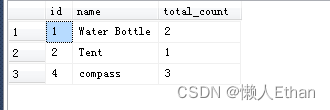SQLServer实现Ungroup操作的示例代码
作者:懒人Ethan
概要
我们经常在SQL Server中使用group by语句配合聚合函数,对已有的数据进行分组统计。本文主要介绍一种分组的逆向操作,通过一个递归公式,实现ungroup操作。
代码和实现
我们看一个例子,输入数据如下,我们有一张产品表,该表显示了产品的数量。

要求实现Ungroup操作,最后输出数据如下:

代码和实现
基本思路
要想实现ungroup,显然需要表格的自连接。自连接的次数取决于total_count的数量。
代码
自连接操作过程中涉及大量的子查询,为了便于代码后期维护,我们采用CTE。每次子查询,total_count自动减一,total_count小于0时,直接过滤掉,该数据不再参与查询。
第1轮查询
获取全部total_count 大于0的数据,即全表数据。
with cte1 as ( select * from products where total_count > 0 ),
输出结果:

第2轮查询
第2轮子查询,以第1轮的输出作为输入,进行表格自连接,total_count减1,过滤掉total_count小于0的产品。
with cte1 as ( select * from products where total_count > 0 ), cte2 as ( select * from ( select cte1.id, cte1.name, (cte1.total_count -1) as total_count from cte1 join products p1 on cte1.id = p1.id) t where t.total_count > 0 ) select * from cte2
输出结果是:

和第1轮相比较,输出结果中没了Flashlight了,因为它的total_count减1后为0,被过滤了。
第3轮查询
第3轮子查询,以第2轮的输出作为输入,进行表格自连接,total_count减1,过滤掉total_count小于0的产品。
with cte1 as ( select * from products where total_count > 0 ), cte2 as ( select * from ( select cte1.id, cte1.name, (cte1.total_count -1) as total_count from cte1 join products p1 on cte1.id = p1.id) t where t.total_count > 0 ), cte3 as ( select * from ( select cte2.id, cte2.name, (cte2.total_count -1) as total_count from cte2 join products p1 on cte2.id = p1.id) t where t.total_count > 0 ) select * from cte3
输出结果如下:

第4轮查询
第4轮子查询,以第3轮的输出作为输入,进行表格自连接,total_count减1,过滤掉total_count小于0的产品。
with cte1 as ( select * from products where total_count > 0 ), cte2 as ( select * from ( select cte1.id, cte1.name, (cte1.total_count -1) as total_count from cte1 join products p1 on cte1.id = p1.id) t where t.total_count > 0 ), cte3 as ( select * from ( select cte2.id, cte2.name, (cte2.total_count -1) as total_count from cte2 join products p1 on cte2.id = p1.id) t where t.total_count > 0 ), cte4 as ( select * from ( select cte3.id, cte3.name, (cte3.total_count -1) as total_count from cte3 join products p1 on cte3.id = p1.id) t where t.total_count > 0 ) select * from cte4
输出结果:

下一次迭代,compass的total_count也将等于0,被过滤掉,查询结果不会再有新的记录,所以查询结束。我们将cte1,cte2,cte3 和 cte4 合并,合并结果即是所求。
代码改进
显然上述代码过于冗长,如果产品数量很多,那子查询的代码也将大幅度增加。
事实上,从第2轮到第4轮的子查询,代码是非常相近的,对于这种情况,无论任何开发语言,我们都可以采用递归的方式进行优化处理。对于此类为题,递归公式如下:
with CTE as ( initial query -- 初始查询 union all -- 查询结果合并 recursive query -- 递归部分,即在查询中直接引用CTE Recursive terminatation condition -- 递归终止条件 )
初始查询,就是我们的第1轮迭代。递归部分,就是我们所谓的相似代码部分。
对于递归终止条件,默认是如果没有新的记录参加递归,则递归终止。本例是按照业务逻辑,设置的终止条件,即total_count需要大于0,这样也可以做到过滤到最后,不会再有新的记录参与到递归中。
按照上述供述,得到的查询代码如下:
with cte as ( select * from products where total_count > 0 union all select * from ( select cte.id, cte.name, (cte.total_count -1) as total_count from cte join products p1 on cte.id = p1.id) t where t.total_count > 0 ) select id, name from cte order by id, name
当我们使用CTE时候,发现每次查询的代码类似,就可以考虑采用上述递归公式对代码进行优化。找到初始查询结果,在相似的代码中找到递归部分以及递归终止条件。
附录
建表和数据初始化代码
if OBJECT_ID('products', 'U') is not null
drop table products
create table products
(
id int primary key identity(1,1),
name nvarchar(50) not null,
total_count int not null
)
insert into products (name, total_count) values
('Water Bottle', 3),
('Tent', 2),
('Flashlight', 1),
('compass',4)到此这篇关于SQLServer实现Ungroup操作的示例代码的文章就介绍到这了,更多相关SQLServer Ungroup操作内容请搜索脚本之家以前的文章或继续浏览下面的相关文章希望大家以后多多支持脚本之家!
